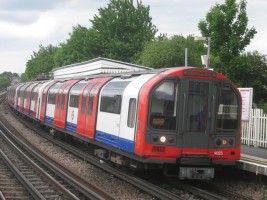
Siemens 25 at Sagrado Corazon, March 20, 2016
I was in Puerto Rico for a week of vacation back in March. The reality of public transit in Puerto Rico is that outside of San Juan, whether you are a tourist or resident of the island, you really need to drive to get to where you are going. Formal, organized public transportation is pretty much nonexistent outside of San Juan, and even intercity public transportation is often limited to “publicos”, shared vans that operate on an ad-hoc basis. However, within San Juan itself, the transit system can be relied upon and is a less harrowing experience than trying to navigate the city streets by car.
The bus system, Autoridad Metropolitana de Autobuses de Puerto Rico, operates a mix of Orion Vs, Orion VIIs, and Gillig Advantages, equipment that you’d find pretty much anywhere else in the continental United States. The fleet itself has about 200 buses and there are about 30 routes criscrossing the city. Unfortunately, despite the picture you might make based on reading those statistics, the utility of the system is a bit more limited. Service ceases to operate by 9 PM on weekdays and 8 PM on Saturdays, and only two routes have any Sunday service to speak of. Also, bus stops have no information about what routes stop there, there are no posted schedules, and there is no real time information available for passengers, one really needs to know where he or she is going ahead of time.

Artwork at the Sagrado Corazon Station, March 20, 2016
There is one rapid transit service on the island, the Tren Urbano that serves San Juan and some of the surrounding area. However, the line is practically useless to anyone other than people living or traveling along its single route, and I know people who are from Puerto Rico who have never set foot on it. Unlike the bus system, Tren Urbano operates 7 days a week. However, service is quite limited outside of rush hours. I rode on a Sunday when the trains ran every 15 minutes, though with a slight decrease in frequency, the line could be operated with only two trainsets instead of the three that I saw in operation. Most of the line is elevated, but there are sections with stations in open cuts as well as s short underground segment. The trains didn’t feel especially fast, especially considering the age of the system (it opened in 2004) and how straight much of the track was. As is often the case with new stations, each one featured artwork, and I liked some of what I saw quite a bit. Unfortunately, the 15 minute headways deterred me from exploring any stations other than the two end of the line stations (I parked at Bayamon, rode to Sagrado Corazon, and rode back to Bayamon to return to the rental car). The trains themselves were comfortable. The system is operated automatically, but each train has an operator on board to control door operation and make announcements despite the presence of automated announcements as well.
Invalid Displayed Gallery
Perhaps most noteworthy in the entire Puerto Rican transit experience is that both the buses and Tren Urbano use fare media identical to New York City’s. Same fareboxes on the buses (they don’t accept bills in Puerto Rico either) and same vending machines on the Tren Urbano, down to the graphics on the touchscreens! I didn’t try using my Metrocard as payment, but it sure felt likely that they would have worked had I tried!
I hope to see an expansion of the Tren Urbano to make it more useful to more people in the traffic choked San Juan area and expansion of the bus system hours to make it more useful in the evenings and on Sundays. Additional information for wayfinding would also be helpful for tourists and residents alike. However, the system could be relied upon within San Juan itself for most of my needs while I was there.. Outside of San Juan, I was glad to have a car.
Check out all of my photos from my trip in the Puerto Rico section!












